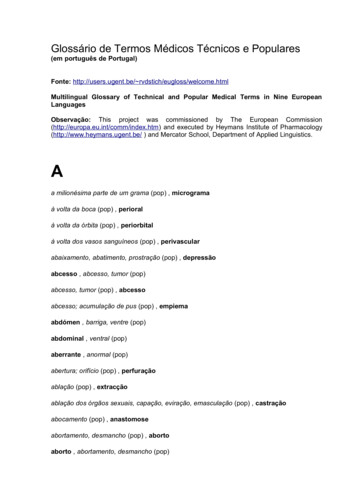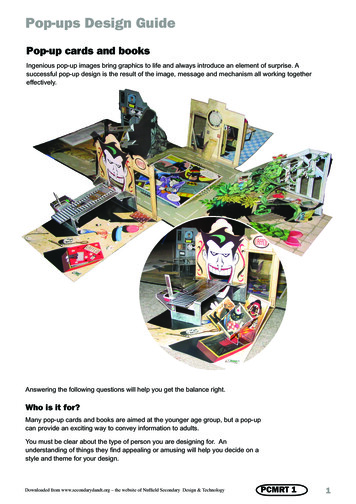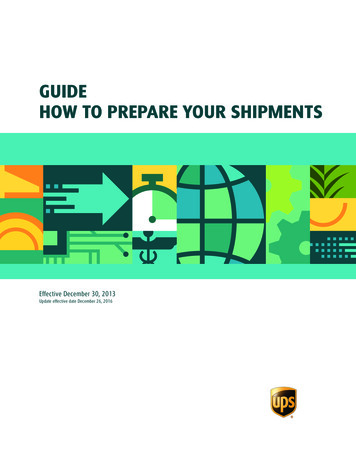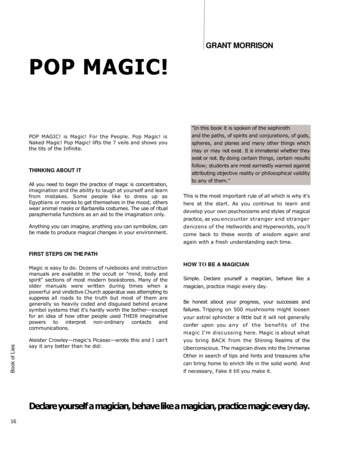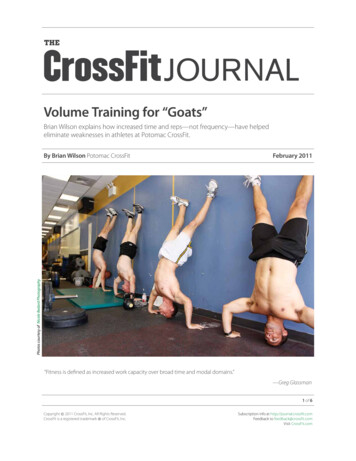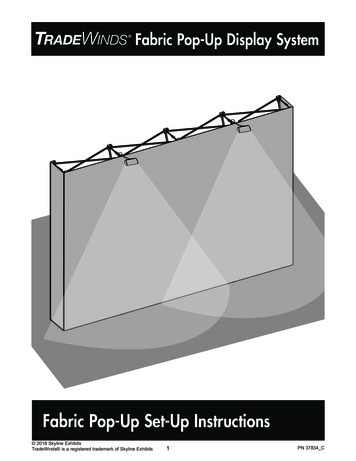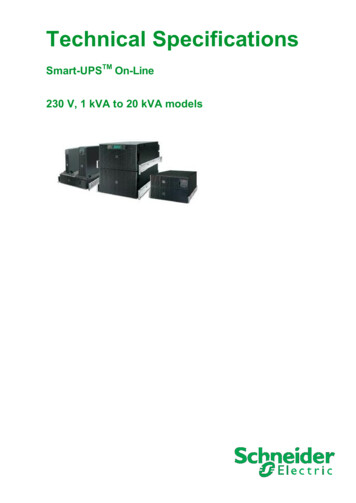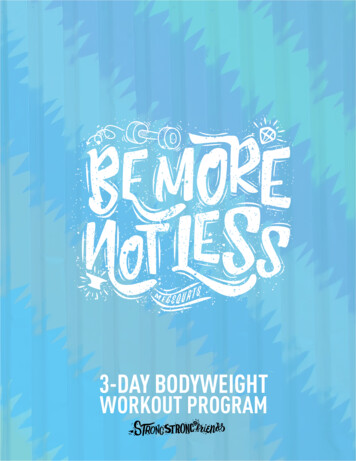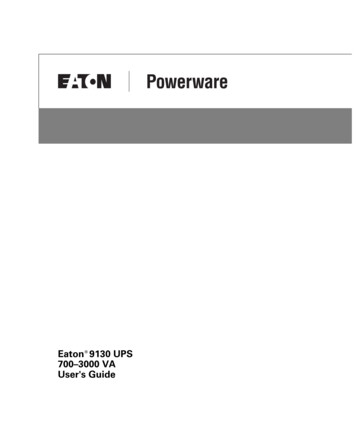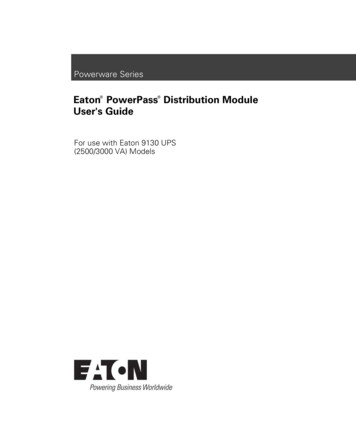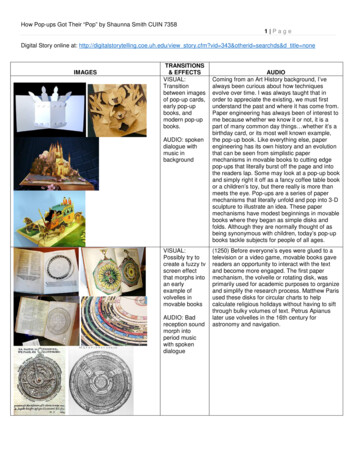
Transcription
How Pop-ups Got Their “Pop” by Shaunna Smith CUIN 73581 PageDigital Story online at: http://digitalstorytelling.coe.uh.edu/view story.cfm?vid 343&otherid searchds&d title noneIMAGESTRANSITIONS& EFFECTSVISUAL:Transitionbetween imagesof pop-up cards,early pop-upbooks, andmodern pop-upbooks.AUDIO: spokendialogue withmusic inbackgroundVISUAL:Possibly try tocreate a fuzzy tvscreen effectthat morphs intoan earlyexample ofvolvelles inmovable booksAUDIO: Badreception soundmorph intoperiod musicwith spokendialogueAUDIOComing from an Art History background, I’vealways been curious about how techniquesevolve over time. I was always taught that inorder to appreciate the existing, we must firstunderstand the past and where it has come from.Paper engineering has always been of interest tome because whether we know it or not, it is apart of many common day things whether it’s abirthday card, or its most well known example,the pop-up book. Like everything else, paperengineering has its own history and an evolutionthat can be seen from simplistic papermechanisms in movable books to cutting edgepop-ups that literally burst off the page and intothe readers lap. Some may look at a pop-up bookand simply right it off as a fancy coffee table bookor a children’s toy, but there really is more thanmeets the eye. Pop-ups are a series of papermechanisms that literally unfold and pop into 3-Dsculpture to illustrate an idea. These papermechanisms have modest beginnings in movablebooks where they began as simple disks andfolds. Although they are normally thought of asbeing synonymous with children, today’s pop-upbooks tackle subjects for people of all ages.(1250) Before everyone’s eyes were glued to atelevision or a video game, movable books gavereaders an opportunity to interact with the textand become more engaged. The first papermechanism, the volvelle or rotating disk, wasprimarily used for academic purposes to organizeand simplify the research process. Matthew Parisused these disks for circular charts to helpcalculate religious holidays without having to siftthrough bulky volumes of text. Petrus Apianuslater use volvelles in the 16th century forastronomy and navigation.
How Pop-ups Got Their “Pop” by Shaunna Smith CUIN 73582 PageVISUAL: imageAUDIO: spokendialogue withmusic inbackgroundVISUAL:Transitionbetween imagesAUDIO: spokendialogue withmusic inbackgroundVISUAL: imageAUDIO: spokendialogue withmusic inbackgroundVISUAL:Transitionbetweenimages, video(1719) Folds were introduced as another way toshare academic research and educate adults.Johann Remmelin produced an anatomy text(Catoptrum Microcosmicum) that used folds touncover the parts of the body that were notobvious to the naked eye such as, tissue, bones,and muscles.(1765) Folds were later used to engage andentertain children. Robert Sayer created the firstmovable book explicitly for children, called“harlequinades” or turn up books. These werepamphlet-like books that were made up of aseries of gatefold flaps that the reader could lift inorder to advance the story and illustrations.Based on that success, English publishers beganto cater to children by producing paper dolls(Little Fannie, The Paignion) and other relatedproducts in addition to books.(1850s) In the US, Dean & Sons created the first3-D illustrations called “peep shows”, also knownas tunnel books, which used superimposedimages to create a type of virtual reality.AUDIO: spokendialogue withmusic inbackgroundVISUAL:Meggendorfervideo clipsAUDIO:VISUAL: videoof transformingmagic windowsAUDIO:(1880s) Pull tabs burst onto the scene whenLothar Meggendorfer refined the use of rivets tocreate life-like movements. Still keeping imagesconfined to 2-Dimensions, these pull-tabscontrolled rivets, strings, and levers that broughtthe illustration to life. His genius transformed theworld of both movable books and children’sliterature.(1890s) Ernest Nister used pull-tabs in histransformation books. Transformations consistedof two stacked images, cut in such a way that thepull tab could change from one image to theother. He even took it one step further andcreated remarkable pinwheel mechanisms tocreate a spiraling transformation that furtherengaged readers.
How Pop-ups Got Their “Pop” by Shaunna Smith CUIN 73583 PageVISUAL:Transitionbetweenimages, videoAUDIO: spokendialogue withmusic inbackgroundVISUAL:Transitionbetween imagesAUDIO: spokendialogue withmusic inbackgroundVISUAL:Transitionbetween imagesAUDIO: spokendialogue withmusic inbackground(1898) Other people, like Isabella Braun (Actor),etc utilized pull tabs by layering superimposedimages to create a 3-D space once the readerlifted and pulled the tab. These panoramasallowed for a variety uses whether it was tosimply illustrate the story or to create engaging 3D “theaters” in which children could direct centerstage. Dean & Sons, Meggendorfer, and Nisteralso used pull tabs in this manner.(1920s) Pop-ups, as we know them today, wereborn in the 1920s when Stephan Louis Giraudcreated 3-D mechanisms that were activated byturning the page. His Bookano Series finallyallowed the images to automatically leap off thepage and surprise the reader with every turn.(1950s) Pop-up books got even more “pop” withthe innovations of Vojtech Kubasta. He wastrained as an architect and began using hisdesign skills in commercial graphic design wherehe created 3-D pop-up advertisements andChristmas cards, because he said, that it “[made]them livelier”. In doing so, he was one of the firstto bring pop-up mechanisms into the mainstreamand use them outside of children’s literature.Later, he found his niche when he turned histalents to creating children’s books andeventually worked with greats like, Walt Disney,to create pop-up books that were translated anddistributed worldwide.
How Pop-ups Got Their “Pop” by Shaunna Smith CUIN 73584 PageVISUAL:Transitionbetween imagesAUDIO: spokendialogue withmusic inbackgroundVISUAL:Transitionbetweenimages, videoAUDIO: spokendialogue withmusic inbackground(1980s) Contemporary pop-up books as we knowthem today, employ the traditional papermechanisms of the past and transcend age andgenre boundaries. Ron van der Meer was thefirst paper engineer to insist that pop-ups weren’tlimited to child fans. Teaming up with renownedcontent experts, he created books gearedtowards adults. Although he was first turnedaway by publishers who told him that “adultsweren’t [going to be] interested in pop-up books”,he successfully pursued his ideas and hascreated books on everything from art to sailing.(1990s) Robert Sabuda and Matthew Reinhartare probably the most famous of thecontemporary paper engineers & pop-up artists.Whether you know it or not, you have probablyseen their work because it is everywhere, it’seven showcased on TV programs like Oprah andThe Today Show. Their intricate pop-up booksincorporate mesmerizing paper mechanisms andeven include hidden compartments to bediscovered.
How Pop-ups Got Their “Pop” by Shaunna Smith CUIN 73585 PageVISUAL:Transitionbetweenimages, videoAUDIO: spokendialogue withmusic inbackgroundVISUAL: videoAUDIO: spokendialogue withmusic inbackgroundShould I cut this part? Sabuda, has beeninstrumental in sharing the word of the pop-up byteaching the ins and outs of the craft, as well asthe production process, to enthusiastic followers.Full scale paper mock-ups are created to showexactly what the finished book will look like withevery element and mechanism. All images are“nested” or laid out and placed close together onspecial paper for a double sided print. Handmadedies are used to cut out all of the pieces of thepop-up mechanisms. Artisans take the paperpieces and assemble them by hand-gluing everypiece. Pop-up books, made by the 100,000s areone of the few remaining mass produced items toby primarily handmade.(2007) When Disney was creating the movieEnchanted, they decided that they wanted to payhomage to a timeless aspect of children’sliterature the pop-up book. In order to createflawless transitions for the movie, they enlistedthe help of famed special effects company, ReelFX. Upon exploring the traditional productionprocess of pop-ups, the Reel FX team had totake it one step further and recreate everythingdigitally and provide seamless transitions withexisting video footage. After this “exhausting”process, everyone on the Reel FX team agreedthat they now have a profound respect for thepop-up and for the engineering minds of theartisans who create them in their traditional form.Others employed this method as seen incommercials and music videos.
How Pop-ups Got Their “Pop” by Shaunna Smith CUIN 73586 PageVISUAL:Transitionbetweenimages, videoAUDIO: spokendialogue withmusic inbackgroundSo why are pop-ups still relevant today, in ourmodern world? How have they managed tosurvive and evolve for hundreds of years insteadof disappearing into the land of forgotten fads?It’s simple: due to their tactile nature, the readergets to actively participate in the story because “aflat page of a seemingly normal book can belifted and turned to create a 3D” world that iswaiting to be explored. With pop-ups, everysection works in a different way – every time youturn the page there is a surprise.” What startedwith simple volvelles, folds, and tabs, hasevolved into 3-dimensional paper sculpture.Some may mock their ingenuity or laugh at theirpop culture status, but there is no doubt that popups are engineering marvels. The New YorkTimes said it best: "calling this sophisticatedpiece of engineering a 'pop-up book' is likecalling the Great Wall of China a partition".Regardless if you can respect the engineeringand the history behind the creation of a pop-upbook, there is no denying its ability to bring asmile to your face.
AUDIO: spoken dialogue with music in background (1765) Folds were later used to engage and entertain children. Robert Sayer created the first movable book explicitly for children, called “harlequinades” or turn up books. These were pamphlet-like books that were made up of
